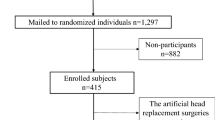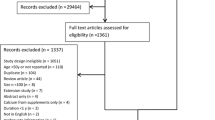Abstract
Background/Objectives:
The effect of vegan diet on bone loss has not been studied. The aim of this study was to examine the association between veganism and bone loss in postmenopausal women.
Subjects/Methods:
The study was designed as a prospective longitudinal investigation with 210 women, including 105 vegans and 105 omnivores. Femoral neck (FN) bone mineral density (BMD) was measured in 2008 and 2010 by dual-energy X-ray absorptiometry (Hologic QDR4500). The incidence of vertebral fracture was ascertained by X-ray report. Serum levels of C-terminal telopeptide of type I collagen (βCTX) and N-terminal propeptide of type I procollagen (PINP) were measured by Roche Elecsys assays. Serum concentration of 25-hydroxyvitamin D and parathyroid hormone were measured by electrochemiluminescence.
Results:
Among the 210 women who initially participated in the study in 2008, 181 women had completed the study and 29 women were lost to follow-up. The rate of loss in FN BMD was −1.91±3.45%/year in omnivores and −0.86±3.81%/year (P=0.08) in vegans. Lower body weight, higher intakes of animal protein and lipid, and corticosteroid use were associated with greater rate of bone loss. The 2-year incidence of fracture was 5.7% (n=5/88) in vegans, which was not significantly different from omnivores (5.4%, n=6/93). There were no significant differences in βCTX and PINP between vegans and omnivores. The prevalence of vitamin D insufficiency in vegans was higher than in omnivores (73% versus 46%; P=0.0003).
Conclusions:
Vegan diet did not have adverse effect on bone loss and fracture. Corticosteroid use and high intakes of animal protein and animal lipid were negatively associated with bone loss.
This is a preview of subscription content, access via your institution
Access options
Subscribe to this journal
Receive 12 print issues and online access
$259.00 per year
only $21.58 per issue
Buy this article
- Purchase on Springer Link
- Instant access to full article PDF
Prices may be subject to local taxes which are calculated during checkout
Similar content being viewed by others
References
Appleby P, Roddam A, Allen N, Key T (2007). Comparative fracture risk in vegetarians and nonvegetarians in EPIC-Oxford. Eur J Clin Nutr 61, 1400–1406.
Barzel US, Massey LK (1998). Excess dietary protein can adversely affect bone. J Nutr 128, 1051–1053.
Chang-Claude J, Hermann S, Eilber U, Steindorf K (2005). Lifestyle determinants and mortality in German vegetarians and health-conscious persons: results of a 21-year follow-up. Cancer Epidemiol Biomarkers Prev 14, 963–968.
Craig WJ (2009). Health effects of vegan diets. Am J Clin Nutr 89, 1627S–1633S.
Ensrud KE, Palermo L, Black DM, Cauley J, Jergas M, Orwoll ES et al. (1995). Hip and calcaneal bone loss increase with advancing age: longitudinal results from the study of osteoporotic fractures. J Bone Miner Res 10, 1778–1787.
Feskanich D, Willett WC, Stampfer MJ, Colditz GA (1996). Protein consumption and bone fractures in women. Am J Epidemiol 143, 472–479.
Genant HK, Wu CY, van Kuijk C, Nevitt MC (1993). Vertebral fracture assessment using a semiquantitative technique. J Bone Miner Res 8, 1137–1148.
Gottfredson M, Puryear R, Phillips S (2005). Strategic sourcing: from periphery to the core. Harv Bus Rev 83, 132–139, 150.
Harrel FE (2001). Regression Modeling Strategies with Applications to Linear Models, Logistic Regression, and Survival Analysis, 1st edn. Springer: New York, NY, 568 p.
Ho-Pham LT, Nguyen ND, Nguyen TV (2009a). Effect of vegetarian diets on bone mineral density: a Bayesian meta-analysis. Am J Clin Nutr 90, 943–950.
Ho-Pham LT, Nguyen PL, Le TT, Doan TA, Tran NT, Le TA et al. (2009b). Veganism, bone mineral density, and body composition: a study in Buddhist nuns. Osteoporos Int 20, 2087–2093.
Hoeting JA (1999). Bayesian model averaging: a tutorial. Stat Sci 14, 382–147.
Holick MF (2007). Vitamin D deficiency. N Engl J Med 357, 266–281.
Jones G, Nguyen T, Sambrook P, Kelly PJ, Eisman JA (1994). Progressive loss of bone in the femoral neck in elderly people: longitudinal findings from the Dubbo osteoporosis epidemiology study. BMJ 309, 691–695.
Jones G, Nguyen T, Sambrook PN, Lord SR, Kelly PJ, Eisman JA (1995). Osteoarthritis, bone density, postural stability, and osteoporotic fractures: a population based study. J Rheumatol 22, 921–925.
Kanis JA (2002). Diagnosis of osteoporosis and assessment of fracture risk. Lancet 359, 1929–1936.
Key TJ, Appleby PN, Spencer EA, Travis RC, Roddam AW, Allen NE (2009a). Mortality in British vegetarians: results from the European Prospective Investigation into Cancer and Nutrition (EPIC-Oxford). Am J Clin Nutr 89, 1613S–1619S.
Key TJ, Appleby PN, Spencer EA, Travis RC, Roddam AW, Allen NE (2009b). Cancer incidence in vegetarians: results from the European Prospective Investigation into Cancer and Nutrition (EPIC-Oxford). Am J Clin Nutr 89, 1620S–1626S.
Limpaphayom KK, Taechakraichana N, Jaisamrarn U, Bunyavejchevin S, Chaikittisilpa S, Poshyachinda M et al. (2001). Prevalence of osteopenia and osteoporosis in Thai women. Menopause 8, 65–69.
Munger RG, Cerhan JR, Chiu BC (1999). Prospective study of dietary protein intake and risk of hip fracture in postmenopausal women. Am J Clin Nutr 69, 147–152.
Nguyen ND, Center JR, Eisman JA, Nguyen TV (2007a). Bone loss, weight loss, and weight fluctuation predict mortality risk in elderly men and women. J Bone Miner Res 22, 1147–1154.
Nguyen ND, Frost SA, Center JR, Eisman JA, Nguyen TV (2007b). Development of a nomogram for individualizing hip fracture risk in men and women. Osteoporos Int 18, 1109–1117.
Nguyen ND, Pongchaiyakul C, Center JR, Eisman JA, Nguyen TV (2005a). Identification of high-risk individuals for hip fracture: a 14-year prospective study. J Bone Miner Res 20, 1921–1928.
Nguyen TV, Howard GM, Kelly PJ, Eisman JA (1998). Bone mass, lean mass, and fat mass: same genes or same environments? Am J Epidemiol 147, 3–16.
Nguyen TV, Center JR, Eisman JA (2000). Osteoporosis in elderly men and women: effects of dietary calcium, physical activity, and body mass index. J Bone Miner Res 15, 322–331.
Nguyen TV, Center JR, Eisman JA (2005b). Femoral neck bone loss predicts fracture risk independent of baseline BMD. J Bone Miner Res 20, 1195–1201.
R Development Core Team (2007). R: A Language and Environment for Statistical Computing. R Foundation for Statistical Computing: Vienna, Austria.
Riggs BL, Khosla S, Melton 3rd LJ (1998). A unitary model for involutional osteoporosis: estrogen deficiency causes both type I and type II osteoporosis in postmenopausal women and contributes to bone loss in aging men. J Bone Miner Res 13, 763–773.
Sellmeyer DE, Stone KL, Sebastian A, Cummings SR (2001). A high ratio of dietary animal to vegetable protein increases the rate of bone loss and the risk of fracture in postmenopausal women. Study of Osteoporotic Fractures Research Group. Am J Clin Nutr 73, 118–122.
Tylavsky FA, Anderson JJ (1988). Dietary factors in bone health of elderly lactoovovegetarian and omnivorous women. Am J Clin Nutr 48, 842–849.
Vinnari M, Montonen J, Harkanen T, Mannisto S (2009). Identifying vegetarians and their food consumption according to self-identification and operationalized definition in Finland. Public Health Nutr 12, 481–488.
Acknowledgements
The study was in fact partly supported by a grant from the Department of Science and Technology of Ho Chi Minh City and the University Commission for Development (CUD) program, Belgium. Dr N Nguyen is supported by a grant from the Australian Medical Bioinformatics Resource (AMBeR). Professor T Nguyen is a recipient of a senior research fellowship from the Australian National Health and Medical Research Council.
Author information
Authors and Affiliations
Corresponding author
Ethics declarations
Competing interests
The authors declare no conflict of interest.
Additional information
Contributors: Study concept and design: LTH-P, TVN and NDN; acquisition of data: LTH-P, BQV, TQL and NDN; and analysis and interpretation of data: NDN, LTH-P, TQL and TVN. Drafting the manuscript: LTH-P, NDN and TVN. Critical revision of the manuscript: LTH-P, NDN, TVN, BQV and TQL. Statistical expertise: NDN and TVN.
Rights and permissions
About this article
Cite this article
Ho-Pham, L., Vu, B., Lai, T. et al. Vegetarianism, bone loss, fracture and vitamin D: a longitudinal study in Asian vegans and non-vegans. Eur J Clin Nutr 66, 75–82 (2012). https://doi.org/10.1038/ejcn.2011.131
Received:
Revised:
Accepted:
Published:
Issue Date:
DOI: https://doi.org/10.1038/ejcn.2011.131
Keywords
This article is cited by
-
Spine, hip, and femoral neck bone mineral density in relation to vegetarian type and status among Taiwanese adults
Archives of Osteoporosis (2023)
-
Chronic diseases are first associated with the degradation and artificialization of food matrices rather than with food composition: calorie quality matters more than calorie quantity
European Journal of Nutrition (2022)
-
Vegetarian and vegan diets and risks of total and site-specific fractures: results from the prospective EPIC-Oxford study
BMC Medicine (2020)
-
Nutritional and health attributes of milk and milk imitations
European Journal of Nutrition (2020)
-
Dietary protein and bone health across the life-course: an updated systematic review and meta-analysis over 40 years
Osteoporosis International (2019)



